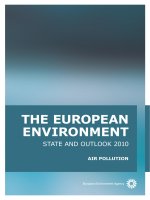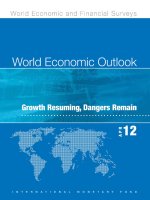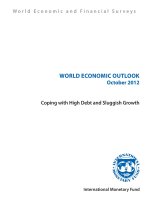World enery outlook IEA WEO 2010
Bạn đang xem bản rút gọn của tài liệu. Xem và tải ngay bản đầy đủ của tài liệu tại đây (343.82 KB, 24 trang )
World Energy Outlook 2010
Nobuo Tanaka
Executive Director
International Energy Agency
Canberra, 25 November 2010
© OECD/IEA 2010
The context: A time of unprecedented
uncertainty
The worst of the global economic crisis appears to be over – but
is the recovery sustainable?
Oil demand & supply are becoming less sensitive to price – what
does this mean for future price movements ?
Natural gas markets are in the midst of a revolution – will it
herald a golden era for gas?
Copenhagen Accord & G‐20 subsidy reforms are key advances –
but do they go far enough & will they be fully implemented ?
Emerging economies will shape the global energy future –
where will their policy decisions lead us ?
© OECD/IEA 2010
Overview of WEO‐2010 scenarios
New Policies Scenario is the central scenario in WEO‐2010
> assumes cautious implementation of recently announced
commitments & plans, even if yet to be formally adopted
> provides benchmark to assess achievements & limitations of recent
developments in climate & energy policy
Current Policies Scenario takes into consideration only those
policies that had been formally adopted by mid‐2010
> equivalent to the Reference Scenario of past Outlooks
The 450 Scenario sets out an energy pathway consistent with the
goal of limiting increase in average temperature to 2OC
© OECD/IEA 2010
Dollars per barrel (2009)
International oil price assumptions
140
Current Policies Scenario
120
New Policies Scenario
100
450 Scenario
80
60
40
20
0
1980
1990
2000
2010
2020
20302035
Scenario
CO2 price
in 2035
($/ tCO2)
International oil price
in 2035
($/bbl)
Effective oil price
in 2035
($/bbl)
Current Policies
42 in EU
135
152 in EU
New Policies
50 in OECD
113
134 in OECD
450 Scenario
120 in OECD
90
139 in OECD
The age of cheap oil is over, though policy action could bring lower international prices than
would otherwise be the case
© OECD/IEA 2010
Mtoe
World primary energy demand by fuel
in the New Policies Scenario
18 000
Other renewables
16 000
Biomass
14 000
Hydro
12 000
Nuclear
10 000
Gas
8 000
Oil
6 000
Coal
WEO-2009 Total:
Reference Scenario
4 000
2 000
0
1980
1990
2000
2010
2020
2030 2035
Fossil fuels maintain a central role in the primary energy mix in the New Policies
Scenario, but their share declines, from 81% in 2008 to 74% in 2035
© OECD/IEA 2010
Recent policy commitments, if
implemented, would make a difference
Mtoe
World primary energy demand by region in the New Policies Scenario
18 000
Rest of world
16 000
China
14 000
OECD
12 000
WEO-2009:
Reference Scenario
10 000
8 000
6 000
4 000
2 000
0
1990 1995 2000 2005 2010 2015 2020 2025 2030 2035
Global energy use grows by 36% in 2008‐2035, with the OECD share of world demand
falling from 44% today to 33% in 2035
© OECD/IEA 2010
Fossil‐fuel subsidies are distorting price
signals
100
Additional
subsidy in 2008
80
Electricity
60
Gas
Oil
Coal
(generated from
fossil fuels)
40
20
0
Iran
Saudi Arabia
Russia
India
China
Egypt
Venezuela
Indonesia
UAE
Uzbekistan
Iraq
Kuwait
Pakistan
Argentina
Ukraine
Algeria
Malaysia
Thailand
Bangladesh
Mexico
Turkmenistan
South Africa
Qatar
Kazakhstan
Libya
Billion dollars
Economic value of fossil‐fuel consumption subsidies by country, 2009
Fossil‐fuel consumption subsidies amounted to $312 billion in 2009, down from
$558 billion in 2008, with the bulk of the fall due to lower international prices
© OECD/IEA 2010
Oil production becomes less crude
mb/d
World oil production by type in the New Policies Scenario
100
Unconventional oil
80
Natural gas liquids
60
Crude oil:
fields yet to be found
40
Crude oil:
fields yet to be developed
20
Crude oil:
currently producing fields
Total crude oil
0
1990 1995 2000 2005 2010 2015 2020 2025 2030 2035
Global oil production reaches 96 mb/d in 2035 on the back of rising output of natural gas
liquids & unconventional oil, as crude oil production plateaus
© OECD/IEA 2010
More oil from fewer producers
Incremental oil production by key country in the New Policies Scenario, 2009‐2035
Saudi Arabia
Iraq
Brazil
Kazakhstan
Canada
Venezuela
UAE
Kuwait
Iran
Qatar
Nigeria
Libya
Algeria
OPEC
Non-OPEC
0
1
2
3
4
5
6
mb/d
Production rises most in Saudi Arabia & Iraq, helping to push OPEC’s market share from
41% today to 52% by 2035, a level last seen prior to the first oil shock of 1973‐1974
© OECD/IEA 2010
A golden age for gas?
Gas is set to play a key role in meeting the world’s energy needs
> demand rises by 44%, led by China & Middle East
Unconventional gas accounts for 35% of the increase in global
supply to 2035, with new non‐US producers emerging
Gas glut will peak soon, but may dissipate only very slowly
The glut will keep pressure on gas exporters to move away from
oil‐price indexation, notably in Europe
Lower prices could lead to stronger demand for gas, backing out
renewables & coal in power generation
© OECD/IEA 2010
Coal remains the backbone of global
electricity generation
TWh
Coal‐fired electricity generation by region in the New Policies Scenario
12 000
China
India
10 000
Other non-OECD
8 000
OECD
6 000
4 000
2 000
0
1990
2000
2010
2020
2030 2035
A drop in coal‐fired generation in the OECD is offset by big increases
elsewhere, especially China, where 600 GW of new capacity exceeds the current coal‐fired
capacity of the US, EU & Japan
© OECD/IEA 2010
Renewables enter the mainstream….
Renewable primary energy demand in the New Policies Scenario
OECD Pacific
2008
2035
Africa
India
Brazil
China
United States
European Union
0
100
200
300
400
500
Mtoe
The use of renewable energy triples between 2008 & 2035, driven by the power sector
where their share in electricity supply rises from 19% in 2008 to 32% in 2035
© OECD/IEA 2010
….but only if there is enough
government support
Billion dollars (2009)
Annual global support for renewables in the New Policies Scenario
210
Biofuels
180
Renewables-based
electricity
150
120
90
60
30
0
2007 2008 2009
2015 2020 2025 2030 2035
Government support remains the key driver – rising from $57 billion in 2009 to $205 billion
in 2035 – but higher fossil‐fuel prices & declining investment costs also spur growth
© OECD/IEA 2010
China becomes the market leader in
low‐carbon technologies
China’s share of cumulative global additions to 2035 for selected technologies
30%
Capacity additions
105 GW
Passenger car sales
335 GW
20%
8.5 million
vehicles
85 GW
10%
0%
Solar PV
Wind
Nuclear
Electric &
plug-in hybrids
Given the sheer scale of China’s market, its push to expand the role of low‐carbon energy
technologies is poised to play a key role in driving down costs, to the benefit of all countries
© OECD/IEA 2010
The 450 Scenario:
A roadmap from 3.5C to 2C
The 450 Scenario sets out an energy pathway consistent with
limiting the increase in temperature to 2C
Assumes vigorous implementation of Copenhagen Accord
pledges to 2020 & much stronger action thereafter
The failure of the Copenhagen Accord pledges:
> As many lack transparency, there is 3.9 Gt of uncertainty over the
level of abatement pledged to 2020
> As many lack ambition, the cost of achieving the 2 C goal has
increased by $1 trillion in 2010‐2030 compared with WEO‐2009
© OECD/IEA 2010
The 450 Scenario:
Abatement by technology
Gt
World energy‐related CO2 emission savings by technology in the
450 Scenario relative to the Current Policies Scenario
45
Current Policies
Scenario
40
42.6 Gt
35
20.9 Gt
30
Share of cumulative abatement
between 2010-2035
Efficiency
Renewables
Biofuels
Nuclear
CCS
53%
21%
3%
9%
15%
25
450 Scenario
20
2008
2015
2020
2025
2030
21.7 Gt
2035
In the 450 Scenario, compared with the Current Policies Scenario, efficiency measures
provide 53% of the necessary abatement, but renewables, CCS & nuclear are also crucial
© OECD/IEA 2010
The 450 Scenario:
Abatement by country
Gt
World energy‐related CO2 emission savings by country in the 450 Scenario
relative to the Current Policies Scenario
45
Current Policies
Scenario
40
42.6 Gt
35
20.9 Gt
30
25
450 Scenario
20
2008
2015
2020
2025
2030
21.7 Gt
Share of cumulative abatement
between 2010-2035
China
United States
European Union
India
Middle East
Russia
33%
15%
9%
8%
5%
3%
Japan
Rest of world
3%
24%
2035
In the 450 Scenario, compared with the Current Policies Scenario, China & the US account
for 48% of the cumulative emission abatement that is needed in 2010‐2035
© OECD/IEA 2010
Achieving the 2°C goal will require rapid
decarbonisation of global energy
Average annual change in CO2 intensity in the 450 scenario
6%
5%
4%
A four-fold
increase needed
3%
2%
1%
0%
1990-2008
2008-2020
2020-2035
Carbon intensity would have to fall at twice the rate of 1990‐2008 in the period 2008‐2020
& almost four times faster in 2020‐2035
© OECD/IEA 2010
Primary coal demand trends
Mtce
World primary coal demand by scenario
8 000
Current Policies Scenario
7 000
6 000
New Policies Scenario
5 000
4 000
450 Scenario
3 000
2 000
1980
1990
2000
2010
2020
2030 2035
In the New Policies Scenario, demand for coal increases by 20% in 2008‐2035, with almost
all of the growth before 2020. Demand is significantly higher in the Current Policies
Scenario and much lower in the 450 Scenario
© OECD/IEA 2010
Peak coal capacity in the 450 scenario
GW
World installed coal‐fired generation capacity in the 450 Scenario
relative to the Current Policies Scenario
3 500
3 000
2 500
Reduced capacity needs from
the Current Policies Scenario
to the 450 Scenario
2 000
1 500
1 000
Total installed capacity
in the 450 Scenario
500
0
2009
2015
2020
2025
Plants built before 2000
Plants built after 2000
Under construction
New coal additions without CCS
New coal additions with CCS
2030
2035
Additional early retirements
Reduced generation needs
450 Scenario installed capacity
Current Policies Scenario installed capacity
© OECD/IEA 2010
A fundamental change is needed in
power generation
Share of world electricity generation by type and scenario
100%
Low-carbon generation in the NPS
80%
Additional low-carbon generation
in 450 Scenario
60%
Fossil-fuel fired generation
in the 450 Scenario
40%
20%
0%
2010
2015
2020
2025
2030
2035
Low‐carbon technologies account for over three‐quarters of global power generation by
2035 in the 450 Scenario, a four‐fold increase on today
© OECD/IEA 2010
… and also in transport
70
700
60
600
50
500
40
400
30
300
20
200
10
100
0
2010
Grammes per kWh
Million
Sales of plug‐in hybrid and electric vehicles in the 450 Scenario
& CO2 intensity of the power sector
Plug-in hybrids
Electric vehicles
CO2 intensity in
power generation
(right axis)
0
2015
2020
2025
2030
2035
Plug‐in hybrids & electric vehicles reach 39% of light‐duty vehicle sales by 2035, making a
big contribution to CO2 abatement, thanks to a major decarbonisation of the power sector
© OECD/IEA 2010
Will peak oil be a guest or the spectre
at the feast?
100
16
96
12
92
8
88
4
84
0
80
-4
76
-8
72
-12
China
68
-16
OECD
2009
2015
2020
2025
2030
mb/d
mb/d
Oil demand in the 450 Scenario
World demand in
New Policies Scenario
World demand in
450 Scenario
Peak demand
Right axis:
Inter-regional
(bunkers)
Other non-OECD
India
2035
Oil demand peaks at 88 mb/d before 2020 & falls to 81 mb/d in 2035, with a plunge in
OECD demand more than offsetting continuing growth in non‐OECD demand
© OECD/IEA 2010
Summary & conclusions
Recently announced policies can make a difference, but fall well
short of what is needed for a secure & sustainable energy future
Lack of ambition in Copenhagen has increased the cost of
achieving the 2C goal & made it less likely to happen
CCS will be essential, Australia can play a leading role
The age of cheap oil is over, though policy action could bring
lower international prices than would otherwise be the case
Renewables are entering the mainstream, but long‐term support
is needed to boost their competitiveness
The greatest potential for emissions abatement – including in
Australia – lies in energy efficiency
Australia is well positioned as a supplier of gas & coal to the
region, but may face growing competition & demand uncertainty
© OECD/IEA 2010









